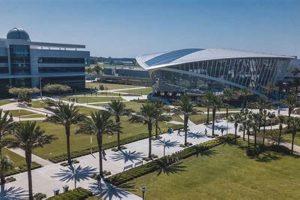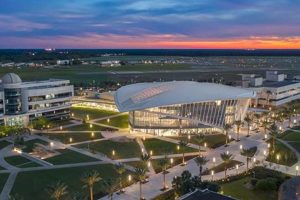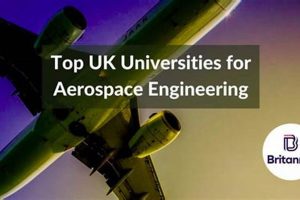Institutions of higher education in Florida that specialize in aviation and space-related fields offer specialized curricula and research opportunities. These schools typically provide undergraduate and graduate programs in aerospace engineering, aeronautical science, and related disciplines. The presence of such institutions is bolstered by Florida’s historical connection to space exploration and a concentration of related industries.
These institutions contribute significantly to the aerospace sector by producing a skilled workforce, fostering technological innovation, and engaging in research that advances the field. Their proximity to major aerospace companies and government facilities facilitates valuable partnerships and provides students with practical experience. Historically, Florida’s geographical location and favorable climate have made it a crucial hub for aerospace activities, influencing the development and prominence of these specialized universities.
The following sections will detail specific programs offered, research initiatives undertaken, and the impact of these universities on both the state and the national aerospace landscape. A deeper examination will reveal the specific strengths and specializations of each relevant institution, showcasing their contributions to the advancement of aerospace technology and education.
Guidance for Prospective Students
Individuals considering pursuing aerospace-related education within the state should carefully evaluate several key factors to maximize their academic and professional success. A strategic approach to selecting an institution and program is crucial.
Tip 1: Research Program Specialization: Different institutions offer unique areas of focus within aerospace. Prospective students should identify their specific interests, such as propulsion systems, avionics, or space systems engineering, and select a program accordingly. For example, one university might excel in astronautical engineering, while another is stronger in aviation management.
Tip 2: Assess Faculty Expertise and Research Opportunities: Investigate the faculty’s credentials and research activities. Look for professors with relevant industry experience or publications in respected journals. Active research programs offer opportunities for student involvement and hands-on learning. Review faculty profiles and university research websites to identify potential mentors and projects.
Tip 3: Evaluate Internship and Career Placement Services: Determine the institution’s track record in placing graduates in relevant industries. Strong connections with aerospace companies and government agencies provide valuable internship and job opportunities. Inquire about career fairs, networking events, and alumni networks that facilitate career advancement.
Tip 4: Consider Location and Campus Environment: Proximity to aerospace industry hubs can offer advantages in terms of networking and employment prospects. Evaluate the campus culture, facilities, and support services to ensure a conducive learning environment. Consider the cost of living in the surrounding area.
Tip 5: Review Accreditation and Program Outcomes: Ensure that the program is accredited by a recognized accreditation body, such as ABET for engineering programs. Examine data on graduation rates, job placement rates, and average salaries to assess the program’s effectiveness. Accreditation signifies a commitment to quality and assures employers of the program’s rigor.
Tip 6: Explore Financial Aid and Scholarship Options: Investigate available financial aid packages, scholarships, and grants to reduce the cost of education. Many institutions offer specific scholarships for aerospace students. Research external funding opportunities from organizations such as NASA or aerospace industry associations.
Careful consideration of these factors will enable prospective students to make informed decisions, maximizing their chances of success in the competitive aerospace field. A well-chosen academic path is a foundational element for a fulfilling and impactful career.
The following sections will delve into the specific programs and opportunities available, providing a detailed overview of institutions and academic options within the state.
1. Academic Programs
Institutions of higher learning in Florida dedicated to aerospace education offer a comprehensive range of academic programs designed to meet the demands of the aerospace industry. These programs form the cornerstone of workforce development and technological innovation within the state’s aerospace sector.
- Undergraduate Engineering Curricula
Bachelor’s degree programs in aerospace engineering, aeronautical science, and related fields provide foundational knowledge in areas such as aerodynamics, propulsion, structures, and flight dynamics. These programs typically include hands-on laboratory experiences and design projects that allow students to apply theoretical concepts to practical problems. The curriculum is designed to prepare graduates for entry-level engineering positions in the aerospace industry or for further graduate study.
- Graduate Research Opportunities
Master’s and doctoral programs offer advanced study and research opportunities in specialized areas of aerospace engineering. Students can conduct research under the guidance of faculty experts in fields such as hypersonic flight, composite materials, and space systems design. These graduate programs contribute to the advancement of aerospace technology and prepare students for leadership roles in research and development.
- Aviation-Specific Programs
Beyond engineering, universities also offer programs in aviation management, air traffic control, and professional pilot training. These programs cater to the operational and logistical aspects of the aerospace industry, preparing graduates for careers in airline management, airport operations, and flight instruction. Such programs are critical to supporting the broader needs of the aviation ecosystem.
- Interdisciplinary Studies
Recognizing the increasingly complex nature of the aerospace industry, some institutions offer interdisciplinary programs that combine aerospace engineering with other fields, such as computer science, electrical engineering, or business administration. These programs equip students with a broader skill set and prepare them to address multifaceted challenges in the aerospace sector, such as autonomous systems or space-based entrepreneurship.
The diversity and depth of academic programs offered by Florida’s aerospace-focused universities ensure a steady pipeline of qualified professionals to support the state’s aerospace industry. These programs directly contribute to economic growth, technological advancement, and the continued prominence of Florida as a hub for aerospace activity.
2. Research Capabilities
The research capabilities of aerospace-focused universities within Florida are integral to the state’s position as a center for aerospace innovation and development. These institutions serve as engines of discovery, conducting fundamental and applied research that directly impacts the aerospace industry and beyond.
- Hypersonic Flight Research
Several institutions possess specialized facilities and expertise in hypersonic flight, enabling them to conduct research on high-speed aerodynamics, propulsion systems, and materials science relevant to future aerospace vehicles. For instance, wind tunnels capable of simulating hypersonic conditions allow researchers to study the behavior of aircraft at extreme speeds. The data and knowledge generated contribute to advancements in missile defense, space access, and high-speed transportation systems.
- Space Systems Engineering
Universities engage in research related to the design, development, and operation of space-based systems, including satellites, spacecraft, and launch vehicles. Activities include developing advanced propulsion technologies, improving satellite communication systems, and designing more efficient solar power generation. The results contribute to the development of new space exploration missions, improved Earth observation capabilities, and enhanced satellite-based services.
- Advanced Materials and Manufacturing
A significant area of research focuses on the development and characterization of advanced materials for aerospace applications, such as lightweight composites and high-temperature alloys. Researchers explore innovative manufacturing techniques, including additive manufacturing (3D printing), to create complex aerospace components with improved performance and reduced weight. These efforts lead to the development of stronger, lighter, and more fuel-efficient aircraft and spacecraft.
- Autonomous Systems and Robotics
Universities are actively involved in research on autonomous systems and robotics for aerospace applications, including unmanned aerial vehicles (UAVs), autonomous spacecraft navigation, and robotic assembly in space. Research activities focus on developing advanced control algorithms, sensor fusion techniques, and artificial intelligence for autonomous decision-making. The results enable the development of safer, more efficient, and more versatile aerospace systems for a wide range of applications, from surveillance to planetary exploration.
These research capabilities, among others, are supported by collaborations with NASA, the Department of Defense, and private aerospace companies. This collaborative environment ensures that research efforts are aligned with the needs of the industry and that research findings are translated into practical applications. The ongoing research at aerospace universities in Florida plays a vital role in maintaining the state’s competitive edge in the aerospace sector and driving future innovation.
3. Industry Partnerships
The strength and pervasiveness of industry partnerships significantly enhance the value proposition of aerospace-focused universities in Florida. These collaborations are not merely symbolic; they represent a crucial mechanism for aligning academic curricula with industry needs, facilitating technology transfer, and providing students with invaluable practical experience. For instance, joint research projects with companies like Boeing or Lockheed Martin offer students the opportunity to work on real-world challenges, thereby bridging the gap between theoretical knowledge and practical application. This alignment directly impacts the quality of graduates and their readiness to contribute effectively upon entering the workforce.
Furthermore, industry partnerships often manifest in the form of internships, co-op programs, and sponsored research. These engagements provide students with hands-on experience within actual operational environments, enabling them to develop crucial skills and professional networks. Universities may also offer specialized training programs developed in consultation with industry partners, ensuring that graduates possess the specific competencies sought by employers. An illustrative example is the development of a specialized avionics course at a Florida university, created in response to a specific skills gap identified by a local aerospace firm. This type of responsive programming ensures that the workforce pipeline remains relevant and adaptable to evolving industry demands.
In conclusion, industry partnerships represent a vital component of the aerospace education ecosystem in Florida. These collaborations foster innovation, enhance the quality of academic programs, and prepare graduates to meet the challenges of a dynamic industry. While challenges remain in cultivating and sustaining these relationships, the demonstrable benefits underscore their critical importance for the continued success of both aerospace universities and the aerospace industry within the state. The strategic cultivation of these partnerships ensures a continuous cycle of innovation, talent development, and economic growth.
4. Geographic Proximity
The concentration of aerospace universities in Florida exhibits a direct correlation with the state’s longstanding role as a prominent hub for aerospace activities. Proximity to key industry assets, such as the Kennedy Space Center, Cape Canaveral Space Force Station, and a multitude of aerospace companies, creates a synergistic environment conducive to education, research, and workforce development. This geographic relationship is not coincidental; rather, it represents a deliberate alignment intended to capitalize on the state’s inherent advantages in the aerospace sector. The physical closeness fosters frequent interactions between academic institutions and industry partners, leading to collaborative research projects, internship opportunities, and technology transfer initiatives. These interactions directly contribute to the relevance and quality of aerospace education programs, ensuring they remain aligned with the evolving needs of the industry.
Consider the practical implications of this geographic alignment. Students attending aerospace universities in Florida gain unparalleled access to industry professionals and facilities. Field trips to launch sites, guest lectures from leading engineers, and hands-on training in state-of-the-art laboratories provide invaluable learning experiences that cannot be replicated in a purely theoretical setting. Furthermore, the clustering of aerospace companies around these universities facilitates the recruitment of graduates and promotes the creation of new businesses within the aerospace ecosystem. A concrete example is the rise of commercial space companies in the vicinity of the Kennedy Space Center, drawing heavily on the talent pool generated by nearby universities with strong aerospace programs. This virtuous cycle of education, innovation, and economic growth underscores the strategic importance of geographic proximity.
In summary, the geographic concentration of aerospace universities in Florida is a key factor in the state’s success as an aerospace leader. The proximity to industry assets fosters collaboration, enhances educational quality, and drives economic development. While challenges such as maintaining funding and adapting to changing technological landscapes persist, the fundamental importance of geographic alignment remains a cornerstone of Florida’s aerospace strategy. This strategic positioning enables the state to cultivate a skilled workforce, attract industry investment, and maintain a competitive advantage in the global aerospace market.
5. Economic Impact
Aerospace-focused universities in Florida represent significant drivers of economic activity, influencing the state’s economy through multiple channels. Their presence generates direct economic impact through institutional spending, including faculty and staff salaries, infrastructure investments, and operational expenditures. These expenditures contribute to the local economies of the communities in which they are located, supporting businesses and generating tax revenue. Furthermore, the universities attract students from outside the state, injecting additional funds into the Florida economy through tuition, housing, and consumer spending. The concentration of highly skilled graduates also makes the state more attractive to aerospace companies considering relocation or expansion, leading to further investment and job creation.
Beyond direct spending, the universities have a substantial indirect economic impact through their research activities and industry partnerships. Research grants and contracts, often funded by federal agencies or private companies, fuel innovation and technological advancements. These advancements can lead to the creation of new products, processes, and even entirely new industries, further stimulating economic growth. The universities also play a critical role in workforce development, producing graduates with the skills and knowledge necessary to support the aerospace sector. A skilled workforce enhances the competitiveness of Florida’s aerospace industry, attracting additional investment and creating high-paying jobs. For example, the presence of specialized aerospace engineering programs has been cited as a key factor in attracting aerospace manufacturers to establish operations in the state.
In conclusion, the economic impact of aerospace universities in Florida extends far beyond their immediate institutional spending. They serve as catalysts for innovation, workforce development, and industry attraction, contributing significantly to the state’s overall economic prosperity. While challenges exist in maintaining funding for research and ensuring that academic programs remain aligned with industry needs, the economic benefits derived from these institutions are undeniable. Their continued success is crucial for sustaining Florida’s position as a leader in the aerospace sector and driving future economic growth.
Frequently Asked Questions Regarding Aerospace Education in Florida
The following questions address common inquiries pertaining to aerospace-related higher education opportunities within the state of Florida. This information aims to provide clarity and guidance for prospective students and stakeholders.
Question 1: What distinguishes aerospace programs offered at Florida universities from those in other states?
Aerospace programs in Florida often benefit from close proximity to significant industry assets, including the Kennedy Space Center and various aerospace companies. This adjacency facilitates internships, research collaborations, and direct industry exposure for students, offering distinct advantages over programs located in regions with less concentrated aerospace activity.
Question 2: Are all universities in Florida offering aerospace degrees equally focused on space-related disciplines?
No. While many institutions offer aerospace engineering programs, their emphasis and specialization may vary. Some universities may have a stronger focus on aeronautical engineering or aviation management, while others are more heavily involved in space systems research. Prospective students should carefully review program curricula and faculty expertise to align with their specific interests.
Question 3: What are the primary career paths available to graduates of aerospace programs in Florida?
Graduates can pursue a wide range of career opportunities within the aerospace sector, including roles in engineering design, manufacturing, testing, research and development, project management, and government agencies. Specific career paths may vary based on the student’s chosen specialization and degree level.
Question 4: How significant is industry funding in supporting aerospace research at Florida universities?
Industry funding plays a crucial role in supporting aerospace research, supplementing government grants and institutional investments. Collaborative research projects with aerospace companies provide valuable resources and expertise, contributing to innovation and the development of new technologies. The level of industry funding can vary between institutions and specific research projects.
Question 5: What accreditation should prospective students look for when evaluating aerospace programs in Florida?
Accreditation from ABET (Accreditation Board for Engineering and Technology) is highly recommended for engineering programs. ABET accreditation signifies that the program meets rigorous quality standards and prepares graduates for professional practice. Prospective students should verify the accreditation status of any program they are considering.
Question 6: How does the cost of attendance at aerospace universities in Florida compare to national averages?
The cost of attendance can vary significantly depending on the institution (public vs. private) and the student’s residency status. Public universities generally offer lower tuition rates for in-state residents. Prospective students should research tuition fees, living expenses, and financial aid opportunities to determine the overall affordability of each program.
In summary, pursuing aerospace education in Florida offers unique opportunities due to the state’s strong aerospace industry presence and specialized academic programs. Careful consideration of program focus, research opportunities, industry connections, and accreditation is essential for making informed decisions.
The next section will explore successful alumni and their contributions to the aerospace field.
Conclusion
The preceding analysis underscores the critical role that institutions focused on aerospace education in Florida play within the state’s broader aerospace ecosystem. These universities contribute significantly to workforce development, technological advancement, and economic growth by providing specialized academic programs, conducting cutting-edge research, and fostering strong industry partnerships. Proximity to key aerospace assets further enhances their value proposition, offering students and researchers unique opportunities for practical experience and collaboration.
The continued success of aerospace education within Florida is vital for maintaining the state’s competitive edge in the global aerospace market. Sustained investment in these institutions, coupled with a strategic focus on aligning academic programs with industry needs, will ensure a pipeline of highly skilled professionals ready to meet the challenges and opportunities of the future. Further research and diligent assessment are continually required to reinforce these institutions’ crucial contribution to the sector.







